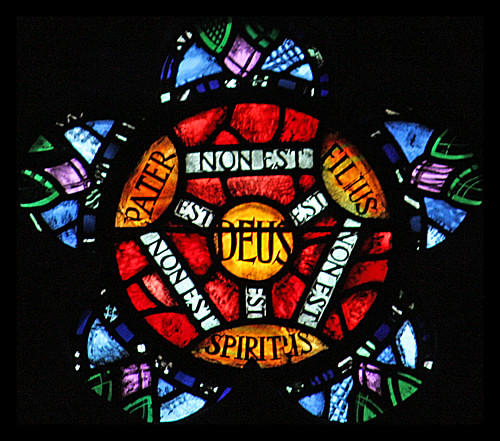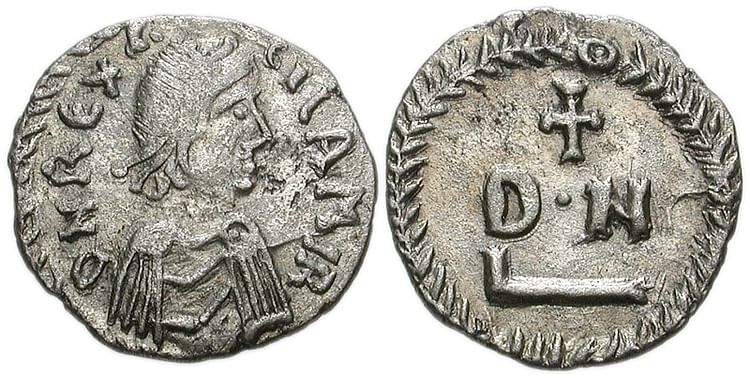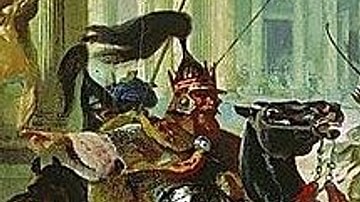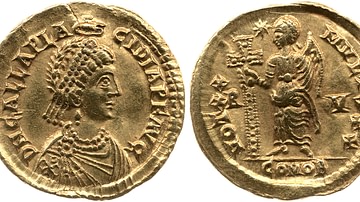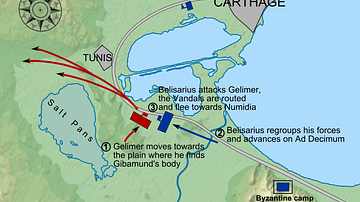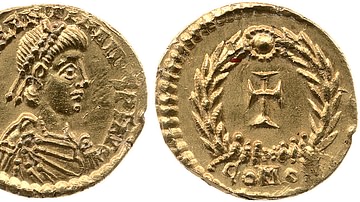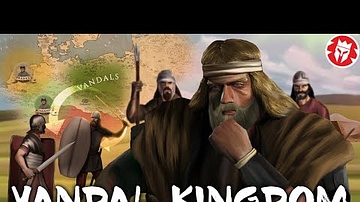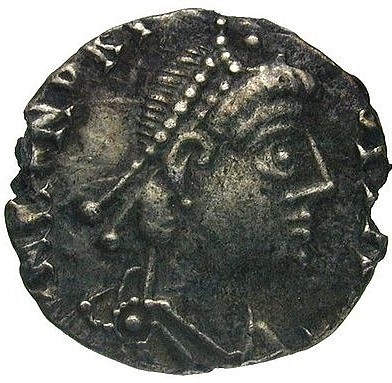
Gaiseric (r. 428-478 CE, also known as Genseric and Geiseric) was the greatest king of the Vandals who remained undefeated from the time he took the throne until his death. He was probably born in 389 CE near Lake Balaton (present-day Hungary), though this is uncertain.
Ancient sources report that he was the illegitimate son of the Vandal king Godigisel who raised him as the equal of his legitimate sons. He was known for his cunning and brilliant military tactics that defeated the armies of Rome in every engagement. He became king of the Vandals in Spain upon the death of his half-brother Gunderic and led his people to North Africa, where he established a Vandal kingdom – so powerful it effectively controlled the Mediterranean Sea from 439-534 CE, seizing ships and plundering coastal towns and villages.
After his death, the kingdom passed to his son who ruled poorly, as did his other successors, until Gelimer (r. 530-534 CE), the last of the Vandal kings, was defeated by the Roman general Belisarius (l. 505-565 CE) in 533 CE, and the Vandals ceased to exist as a cohesive political and cultural entity by 534 CE.
The Vandals in Spain & Gaiseric's Rise to Power
The Vandals migrated from Scandinavia to the region now known as Poland sometime around 130 BCE and then migrated further south, coming into contact with the Roman Empire. By c. 166 CE they were alternately allied to, or antagonists of, Rome and by 270 CE were actively hostile to the empire. The Hunnic invasions of the late 4th and early 5th centuries CE forced many so-called "barbarian tribes" from their traditional homelands across the borders into Roman territory, seeking safety.
The Vandals were denied entrance but, in the winter of 406 CE, they crossed the frozen Rhine River and invaded Gaul. From Gaul, they spread to Hispania (modern-day Spain), where they came into conflict with the Visigoths already living there. Further complicating the Vandals' situation was the presence of Romans in Hispania, and so they found themselves fighting against two enemies on separate fronts. Under the leadership of Gunderic (l. 379-428 CE), the Vandals were able to keep both enemies at bay and took control of the coastal cities with many of the most important ports.
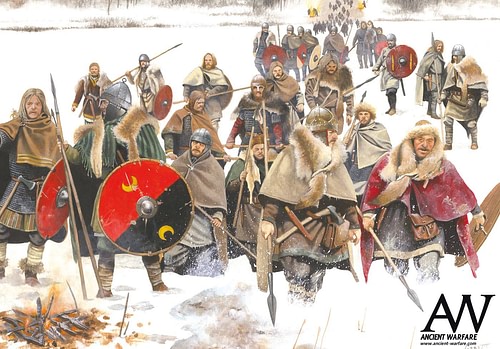
Still, the Vandals were constantly threatened with attacks either by the Romans or the Visigoths. While Gunderic was a capable leader, claiming kingship over the Vandals and the Alans (and so possessed of a fairly large army), there was nothing he could do to conquer and hold Hispania as a whole. Gunderic died in 428 CE and was succeeded by the 39-year-old Gaiseric who recognized he needed to find a solution to his people's problem by leaving Spain and establishing a Vandal kingdom elsewhere.
The Invasion of North Africa
The problem, of course, was where to go, but this was resolved for him by his Roman enemies. While the Vandals were fighting off the Visigoths, the Roman Empire was suffering its usual problems with court intrigue. The emperor in the west was Valentinian III (r. 425-455 CE), who was only a child, and actual power lay with his mother, Galla Placidia (l. 392-450 CE), and the general Flavius Aetius (l. 391-454 CE). Romans generally favored either Aetius or Galla, and the two were almost constantly at work trying to devise plans to thwart the hopes of the other.
In c. 428 CE, Aetius devised a scheme whereby a rival of his, Bonifatius (who ruled in North Africa, d. 432 CE), was charged with treason against Valentinian III and Galla Placidia. Aetius requested that Galla send for Bonifatius to come from North Africa and answer the charges while, at the same time, sending word to Bonifatius that Galla was planning to execute him when he arrived. When Bonifatius sent word to Galla that he would not come, Aetius declared this was proof of his treason.
At this point, the historian Procopius claims, Bonifatius invited the Vandals of Spain to North Africa as allies against a Roman invasion. Bonifatius, as Galla would soon recognize, was innocent of the charges and, as he controlled six provinces in North Africa and the military might to defend them, would have had no need for an agreement with the Vandals. Still, as Aetius and Galla were formidable enemies, Bonifatius could have sent the invitation to Gaiseric in order to muster as many men as he could. Another account of the Vandals' invasion of North Africa suggests that Gaiseric had been injured in a fall from a horse and was lame and so decided to henceforth wage war by sea which led him to invade in order to establish a naval base at Carthage.
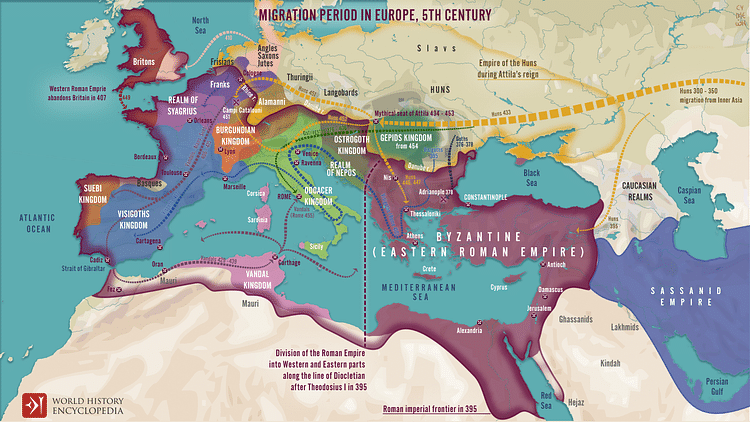
Historians have argued for and against both of these claims and continue to do so. Most likely, Gaiseric simply wanted a homeland for his people that was rich in resources and free of Visigoths and so took advantage of the confused situation of the Romans and invaded when he felt Bonifatius could do nothing about it (or he simply accepted Bonifatius' invitation with a plan in mind to take the province). North Africa was the major grain supplier for the Roman Empire and, if Gaiseric controlled it, he would be able to effectively negotiate with the Romans to his advantage.
Whatever his reasons, Gaiseric led 80,000 of his people from Spain to North Africa in 429 CE. Historians continue to debate whether the number was 80,000 or 20,000, but the historian Walter A. Goffart (citing others) writes:
That Geiseric led 80,000 Vandals and associated peoples from Spain to Africa in 429 has been called the one piece of certain information we have about the size of barbarian groups in the age of the invasions. The certainty arises from its being vouched for by apparently independent informants, one Latin, the other Greek. (231)
Once in Africa, if the claim that Bonifatius invited him is accepted, he turned on his host and led his forces against the imperial army. He took the city of Hippo (where St. Augustine, who died at this time, was bishop) after a siege of fourteen months and overran the territories of present-day Morocco and Algeria.
Gaiseric took hundreds of Roman prisoners captive, many of them high-profile citizens, but treated them well and offered them freedom if they would swear never to take up arms against the Vandals again. Many of them accepted his offer and, among them, was a Roman officer named Marcian who would later become emperor (r. 450-457 CE) and would honor his oath.
Valentinian III, meanwhile, had no choice but to recognize Gaiseric's victories and abandon the North African provinces except for Carthage. Gaiseric steadily built up his power base, conquering other cities and, in 439 CE, he took Carthage. He then continued on with a string of victories, conquering cities until he was master of North Africa and the Vandals had their own homeland, much to the dismay of Rome. Historian Roger Collins writes, "The determination to regain Africa dominated western imperial policy for the next fifteen years" (90). The Romans would be unsuccessful in this, however, until after Gaiseric's death.
Persecutions of the Catholics
With the Romans defeated, Gaiseric went about the business of ruling his kingdom. The Vandals were Arian Christians, while the Romans were Trinitarians (later known as Catholics). The historian Victor of Vita described the persecutions of Catholics under Gaiseric's reign in his History of the Persecution of the African Province (c. 484 CE). The Arian Vandals rejected the concept of the Trinity as polytheistic heresy, while the Roman Catholics condemned Arianism as a threat to the true faith. The Cambridge Ancient History describes the situation after Gaiseric was fully in control of North Africa:
Geiseric and the Vandals had regarded the African provincials, especially the Roman nobility, with considerable suspicion. Members of many leading families were exiled and had their lands expropriated. Similarly, the religious conflict between Arian Vandals and Catholic Romans was unusually savage. Many Catholic bishops and priests were subjected to internal exile, and their churches and landed endowments given to Arians instead. (XIV, 125)
The Vandal king also taxed the Catholics more heavily than the Arians with special attention paid to Catholic churches. The vehemence with which Gaiseric regarded the Trinitarian Christians sprang from the Trinitarians' belief in the trinity (God as Father, Son, and Holy Ghost) as well as their overt antagonism toward the Vandal form of Arian Christianity which incorporated aspects of Christianity into the old Germanic paganism of the tribe.
In the Vandal pagan belief system, Odin was king of the gods and all others were below him and so, in the Vandal form of Christianity, there was only one supreme God and Jesus fulfilled the same role that Thor had previously as a son of the highest god. The concept of three equally powerful deities reigning as one God was totally unacceptable to Gaiseric, as it violated everything he believed concerning the divine. No Catholics were allowed to serve in his government, and every government official had to be a loyal Arian who believed in precisely what Gaiseric believed. These persecutions, however, did not interfere with his rule, and the Vandal Kingdom flourished.
The Sack of Rome
From their port at Carthage the Vandals now launched their fleet at will and controlled the Mediterranean Sea, which formerly had been Rome's. Gaiseric's navy plundered whatever ships crossed their path and raided coastlines. Plans and attempts by the Romans to drive him and his people from North Africa came to nothing and so, in 442 CE, the Romans acknowledged the Vandal Kingdom as a legitimate political entity, and a treaty was signed between Gaiseric and Valentinian III.
In 455 CE, Valentinian assassinated Aetius and was then murdered shortly afterwards by conspirators under Petronius Maximus, who then declared himself emperor. Gaiseric claimed that this nullified the treaty of 442 CE, which had been only valid between himself and Valentinian. He sailed for Italy with his fleet, landed unopposed at Ostia, and marched on Rome. The Romans recognized that their military force was inadequate to meet the Vandals and so put their trust in the diplomatic skills of Pope Leo I (served 440-461 CE) and sent him out to meet Gaiseric and plead for mercy.
Leo told Gaiseric he was free to plunder the city but asked him not to destroy it nor harm the inhabitants - and Gaiseric agreed. This was greatly to Gaiseric's advantage on many points but, mainly, because Italy was suffering a famine and, when he landed at Ostia, Gaiseric recognized that his army would be unable to affect a prolonged siege of the city because they would have nothing to eat and Rome's walls were formidable. His assent to Leo's request, then, was more an act of expediency and prudence than mercy.
Anything of value, from personal treasures to ornaments on buildings and statues, was taken by the Vandals, but they did not destroy the city, and few people were harmed other than Petronius Maximus who was killed by a Roman mob when he tried to flee and was caught outside the walls. The Vandals looted the city and then marched back to their ships and sailed home, taking with them a number of high-profile hostages including Valentinian III's widow and her daughters. Collins writes:
The sack of Rome of 455 had the immediate effect of making the Vandal threat to Italy seem far more menacing than [other threats]. Despite the Vandals immediately returning to Africa with their loot, the whole episode brought home in a way that seems not to have been previously appreciated just how vulnerable Italy, and Rome in particular, was to sea-borne raiding. (88)
Realizing they could no longer afford to tolerate the Vandals in North Africa, the Romans gathered their strength to launch an attack in c.460 CE. Hoping to win a decisive battle, they enlisted the aid of the Vandals' old enemies, the Visigoths, as allies. The fleet gathered in Spain for an invasion of North Africa but Gaiseric, who was always vigilant of Roman military movements, launched a pre-emptive strike and destroyed or captured most of the Roman fleet in 461 CE.
The Battle of Cape Bon
For the next seven years, the Vandals continued to command the Mediterranean Sea and terrorize the coastal settlements. Finally, in 468 CE, Rome decided to try again to rid North Africa of the Vandals and take back their provinces. The eastern and western halves of the empire united against the Vandals and sent the whole of their fleet against them. This campaign might have been successful except for the incompetence of the Roman general Basiliscus (later emperor, r. 475-476 CE) and the cleverness of Gaiseric.
Basiliscus anchored his fleet at Cape Bon instead of driving on to take Carthage directly. Gaiseric, who already knew the invasion was coming, feigned surprise and sent Basiliscus a message asking for a five-day truce so that he could prepare to negotiate a peace and surrender. Basiliscus granted him the five days and then remained in the port at Cape Bon to await the Vandal emissaries with their surrender.
Gaiseric, meanwhile, ordered all the old ships in port at Carthage to be loaded with dried brush, wood, and jars of oil. On the evening of the fifth day, while Basiliscus was still waiting for the Vandal emissaries to arrive, Gaiseric had the old ships towed slowly toward the Roman fleet. The Vandals waited until the night was fully dark and then fired the ships and sent them toward the Roman galleys.
The Roman fleet was packed closely together in the port at Cape Bon and had no room to maneuver to escape the flaming ships of the Vandals. Fire leapt from ship to ship and, as it was a windy night, the flames spread faster. Amidst the smoke and flames, the Vandal fleet emerged, rammed the Roman ships, and boarded them, killing anyone on board who resisted.
When the Vandals were certain there was no fleet left worth worrying about, they withdrew; the Roman ships continued to burn throughout the night, and those ships that could still sail retreated back toward Rome with a loss of over 600 ships and countless lives. The Romans were forced to ask for peace, and the general Ricimer (who was acting head-of-state in the west, d. 472 CE), had to accept Gaiseric's terms, which were simply a restatement of the treaty of 442 CE, allowing the Vandals to do whatever they wanted whenever they pleased.
The Death of Gaiseric & Fall of the Vandal Kingdom
Following this devastating Roman defeat, which had crippled the western empire, Gaiseric mounted a full-scale assault on the eastern empire as retribution. These attacks continued from c. 469 - 475 CE with more Vandal victories than defeats. The Vandals raided the territories of the eastern empire from Alexandria, Egypt up through Anatolia.
When the emperor Leo I died, he was succeeded by Zeno (r. 474-475, 476-491 CE) who almost instantly opened negotiations for peace. Gaiseric, with his customary fairness, asked for no exorbitant terms; he only demanded that Rome recognize his kingdom as legitimate and leave him alone. He granted freedom of religion to the Catholics living in North Africa, agreed to keep his ships from raiding the Anatolian coastline, and freed whatever Roman prisoners he had taken. He remained the uncontested lord of the Mediterranean Sea and of North Africa until his death, by natural causes, at Carthage in 478 CE.
Gaiseric was succeeded by his son Huneric (r. 478-484 CE) who persecuted the Catholics (Trinitarian Christians) at the expense of other, more profitable, pursuits. Unlike Gaiseric's persecutions, Huneric's were particularly intense and took time and effort away from the actual administration of the kingdom. Huneric was followed by other kings who ruled more, or less, successfully than he but who never approached the greatness of Gaiseric.
The last king of the Vandals was Gelimer who was defeated by Belisarius at the Battles of Ad Decimum and Tricameron in 533 CE. Gelimer fled the field and was hunted down and captured in March 534; afterwards he was brought in chains to Constantinople, where he was featured in Belisarius' triumphal parade through the streets and then released.
The eastern empire regained control of North Africa, and the Vandals ceased to exist as a cultural entity. King Gaiseric defeated the Romans in almost every engagement and won more battles against Rome than any other military leader in history. He seemed to be able to guess at what the Romans would do before they even knew and consistently thwarted their plans to drive him from his kingdom. He is remembered in the present day as one of the greatest military strategists in history and the most successful ruler of the Germanic tribes of Late Antiquity.
